U.S. Aviation Sector Shows Resilience Amid Staffing Challenges and Travel Delays
The U.S. aviation industry remains strong and resilient amid temporary air traffic staffing challenges, as airlines and authorities work together to maintain passenger safety, efficient operations, and long-term solutions for smoother travel across the country.
The U.S. aviation industry continues to demonstrate remarkable resilience and coordination despite facing staffing challenges within air traffic control departments. On Saturday, thousands of flights experienced delays across several major cities, yet airline teams and aviation authorities worked tirelessly to minimize disruption and ensure passenger safety.
Even with these operational challenges, the Federal Aviation Administration (FAA) emphasized its commitment to maintaining safety and efficiency across all airports. Major cities including Atlanta, Chicago, San Francisco, Newark, and New York were affected, but swift ground delay programs and rapid response teams helped stabilize flight operations throughout the day.
The U.S. transportation sector has long been known for its strength, flexibility, and problem-solving capacity. Despite external challenges, aviation experts praised the FAA and airline staff for adapting quickly, ensuring that travel continued smoothly for millions of passengers. This highlights the sector’s ability to overcome short-term hurdles while maintaining the highest safety standards.
Officials noted that about 1,500 flights were canceled and 6,000 delayed on Saturday, compared with slightly lower figures the previous day. However, proactive management and clear communication with passengers helped reduce the impact significantly. Airlines such as American, Delta, United, and Southwest coordinated closely with the FAA to maintain safe skies and limit schedule disruptions.
The FAA’s decision to temporarily reduce flight operations at major airports was made as a precautionary measure to ensure continued safety and prevent congestion in the skies. By implementing strategic reductions—starting at 4% and gradually adjusting—authorities demonstrated foresight and responsibility in handling the evolving situation.
Transportation Secretary Duffy reaffirmed that passenger safety and staff welfare remain the top priorities. She noted that the government is working on sustainable staffing solutions and ensuring that all federal employees affected by the temporary shutdown are supported. These actions highlight a strong sense of national responsibility and long-term planning.
The U.S. Senate is also engaged in bipartisan talks to reach an agreement that will ensure smoother operations moving forward. Lawmakers expressed optimism about resolving the issues quickly, reflecting the unified approach of the country’s leadership in safeguarding public infrastructure and essential services.
At airports such as Atlanta, one of the busiest in the world, operations teams displayed incredible professionalism in handling nearly five-hour average delays. Their coordination and clear passenger guidance ensured that the travel experience remained calm and organized, earning appreciation from travelers and aviation analysts alike.
Industry insiders say the aviation community’s spirit of cooperation has been crucial in managing this period. The collaboration between air traffic controllers, pilots, ground staff, and airline management showcases the strength and resilience of the U.S. aviation ecosystem.
Despite temporary setbacks, analysts believe that the aviation sector will bounce back stronger than ever. Airlines are already preparing enhanced schedules, additional training programs, and new digital systems to optimize operations. These innovations aim to prevent future disruptions and improve passenger experience across all airports.
The government’s continued dialogue with aviation leaders reflects a proactive stance focused on long-term stability and modernization. Once the shutdown ends, the FAA plans to introduce enhanced recruitment drives and improved work-life policies for controllers to strengthen the system further.
Overall, this episode stands as a reminder of how the United States aviation industry continues to thrive through unity, innovation, and resilience. It underscores how collaboration between government, airlines, and aviation professionals ensures safety and efficiency, even during challenging times.



